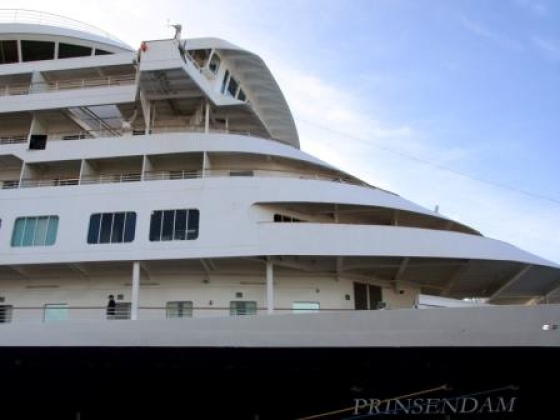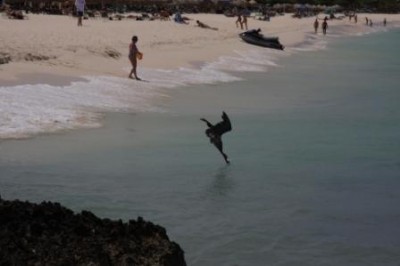Ik had dat aantrekkelijker kunnen inkleden en spreken van “nen tit van kommen en nen tit van goan”, maar als titel vond ik dat wat aangebrand. Om in dezelfde stijl voort te gaan is den tijd van gaan dus wel degelijk gekomen. Dat gevoel overviel me zonder pardon gisteravond, toen ik op mijn kamer kwam na het diner, even naar buiten stapte en daar pardoes voor mij, in het midden van de hemel, de Grote Beer zag staan … zoals thuis, dacht ik direct. Inmiddels zijn er nog andere aanknopingspunten, zoals het weer: regen en wind en een grijze Caribische Zee.
Het is de gewoonte dat men naar het einde toe wat reflecteert en samenvat, en misschien zelfs vooruit blikt. Dat laatste zal ik hier zeker niet doen, en de rest met mate – gewoon omdat ik, in al die niet-intuïtieve drukte, niet veel tijd heb gehad om dingen op één of ander rijtje te zetten, laat staan op één grote rij.
Vooraleer ik ook maar iets anders neerpen, hoop ik dat de verslagen de lezers deugd hebben gedaan, wat ook hun motivatie is geweest om de blog te lezen. Zonder die enthousiaste steun had ik de dagelijkse blog misschien niet volgehouden en was één van mijn concrete doelstellingen – kan ik de discipline opbrengen om dagelijks te schrijven? – aan diggelen geslagen. Ik realiseer me sedert enkele dagen tevens dat die blog straks ook voor mezelf een referentie zal blijven, op menig vlak. Wie weet heb ik de verhalen nodig om mijn vier duizend foto’s van de juiste ondertitels te voorzien!
Hoewel elk vogeltje anders gebekt is – dit zeg ik nu met meer autoriteit dan drie maanden geleden voor redenen die ik gisteren nog heb uitgelegd – kan ik elkeen die van de wereld, van zijn landschappen en culturen houdt, toewensen dat ze de kans krijgen, en grijpen, om dergelijke “Grand Voyage” te maken, te land, ter lucht of ter zee. Het is een ware ontspanning voor diegenen die zich heerlijk willen inspannen om de smeltkroes, de aardse brij waarin ze leven tegelijk breder en van dichtbij te ervaren.
Aangezien ik het filosoferen voor “Conatus” moet laten, een stiefkindje dat binnenkort meer aandacht zal krijgen, keer ik terug naar de aspecten die meer met de reis te maken hebben. Ik geloof dat het onverstandig zou zijn om een top drie van verschillende categorieën samen te stellen. Niet dus, wel een impressie van wat er, zo onmiddellijk voor de vuist weg, bovenuit steekt.
 Ontegensprekelijk zijn Antarctica en Amazonas zonder concurrent in de galerij van unieke ervaringen, waarbij ik de laatste als een ontdekkingsreis naar een soort oorsprong van menselijk leven zie, en de eerste als een onderdompeling in vervlogen geologische tijden. In die zin is het ook geen competitie van a tegen b, ze zijn immers onvergelijkbaar, allebei “buiten categorie”. Terugblikkend op Antarctica heb ik ook vandaag nog het gevoel van een vijandige omgeving, terwijl de Amazone rivier een uitnodigende geborgenheid als echo achterlaat.
Ontegensprekelijk zijn Antarctica en Amazonas zonder concurrent in de galerij van unieke ervaringen, waarbij ik de laatste als een ontdekkingsreis naar een soort oorsprong van menselijk leven zie, en de eerste als een onderdompeling in vervlogen geologische tijden. In die zin is het ook geen competitie van a tegen b, ze zijn immers onvergelijkbaar, allebei “buiten categorie”. Terugblikkend op Antarctica heb ik ook vandaag nog het gevoel van een vijandige omgeving, terwijl de Amazone rivier een uitnodigende geborgenheid als echo achterlaat.
Hoewel ik niet over ontgoocheling wil spreken, blijf ik wat op mijn honger zitten wat betreft het natuurschoon in Chili. De relatief weinige flarden van fjorden, oerwouden, woestijnen en hoge bergen, waarvan ik heb genoten, wegen niet op tegen wat ik denk te hebben gemist. Een drietal weken over land, lucht en zee zouden dat gat zeker kunnen opvullen. Misschien moet ik me specialiseren in Chileense wijn?
Tot slot heb ik wat flash-achtige indrukken. In de hedendaagse wereld kan een beeld enkel blijven hangen als het eenvoudig genoeg is om erover te kunnen twitteren. Aangezien ik zelf nogal in de complexiteit van de dingen en nuances van een oordeel geloof, voel ik me niet in mijn sas in twitterschoenen, maar ik probeer het toch maar. De volgorde heeft geen speciale betekenis.
Rio biedt de verrukkelijkste panorama’s voor landschapsliefhebbers (en strandlopers, vermoed ik). Buenos Aires heeft klasse, zeker qua architectuur, maar ook qua kunst en sociaal leven. Bahia de Salvador biedt een ongeëvenaarde originaliteit en diversiteit. Ushuaia bekoort met zijn rustige, afgelegen en koele woestheid, een aangenaam evenwicht tussen pool en pampa. Quito is als een arendsnest, met recht en reden trots op zichzelf.
Uruguay, en Montevideo, zijn ergens in hun eigen geschiedenis blijven steken. Peru eveneens, hoewel de enorme klassenverschillen straks wellicht wat vuur aan de lonten zullen steken. Zijn isolatie maakt van Robinson Crusoe Eiland een unieke plek voor meditatie, en als je in de buurt bent is het een omweg waart. Waarom pinguïns op de Falklands leven zal ik nooit begrijpen want Vuurland, in de onmiddellijke buurt, is veel en veel aantrekkelijker dan de schrale, oude rotsen van de Malvinas. Tot slot is de “Cordillera de Darwin”, tussen Ushuaia en Punta Arenas, langs de “Beagle Channel”, voor wie van de vistas van het hooggebergte houdt, een evenwaardige versie op vanaf zeeniveau. Tot daar mijn twiets (en met de nodige excuses voor het onrecht dat ik Zuid-Amerika hiermee heb aangedaan).
Uiteraard is deze reis niet compleet zonder Darwin en Spinoza. Er was weinig plaats om hen uitdrukkelijk aan bod te laten komen; ten andere zijn ze moeilijk in een bladzijde te vatten. Ik heb wel degelijk een aantal boeken in die sferen gelezen, de enen al wat makkelijker te begrijpen of te volgen, dan de anderen. Voor diegenen die in deze materies interesse hebben, kan ik twee boeken aanbevelen. Mijn versies waren in het Engels (van Amazon.com) en ik weet niet of ze (reeds) in andere talen beschikbaar zijn.
Het eerste, “The Courtier & The Heretic: Leibniz and Spinoza” (van Matthew Stewart), geeft tegelijk een voor leken begrijpelijk beeld van de filosofie van beide reuzen in het moderne denken, en een boeiende analyse van de dynamiek van de tijdsgeest én van de spionage en manipulatie rond de filosofische leer van Descartes, Spinoza en Leibniz. Wetenschap is niet alleen kennis en feiten, maar eveneens macht en bedrog, zoals we dat ook vandaag meemaken.
 Het tweede boek is “Self comes to Mind: Constructing the Conscious Brain”” van Antonio Damasio, een wereldberoemd neuroloog en tevens expliciet “supporter” van Spinoza en van Darwin. Met zijn dertig jarige carrière in hersenonderzoek betreffende alles wat te maken heeft met oorsprong van gevoelens (versus pure emoties), is hij sinds jaren een toonaangevende autoriteit op het vlak van onderzoek naar begin en wezen van menselijk (en dierlijk) bewustzijn, en naar ons eigen bewustzijn van onszelf. Hij is niet alleen uitzonderlijk beslagen op zijn vakgebied, maar kan het ook op boeiende en meeslepende manier brengen.
Het tweede boek is “Self comes to Mind: Constructing the Conscious Brain”” van Antonio Damasio, een wereldberoemd neuroloog en tevens expliciet “supporter” van Spinoza en van Darwin. Met zijn dertig jarige carrière in hersenonderzoek betreffende alles wat te maken heeft met oorsprong van gevoelens (versus pure emoties), is hij sinds jaren een toonaangevende autoriteit op het vlak van onderzoek naar begin en wezen van menselijk (en dierlijk) bewustzijn, en naar ons eigen bewustzijn van onszelf. Hij is niet alleen uitzonderlijk beslagen op zijn vakgebied, maar kan het ook op boeiende en meeslepende manier brengen.
De tijd die me nog rest zal ik besteden aan pakken, slapen, eten en drinken. (En nog één Engelse blog schrijven). Morgen zal er alvast geen blog verschijnen omdat er teveel losse eindjes aan mekaar moeten worden geknoopt. Ik zal alvast afspraak maken voor een laatste flash, met het verhaal van de blijde thuiskomst – ergens volgende week.
Prinsendam, donderdag 10 maart 2011
Looking forward …. to the “All Ashore!”

 Our brochure advertized the Natural Bridge, the California Lighthouse and the Casibari Rock formations as must-see. I decide to jump in a taxi and do some quick reconnaissance (because I also had to start planning the last laundry and the early packing). The taxi driver informed me that the 25ft high stone bridge had collapsed in2005. The Lighthouse was closed to the public two years ago, because it had been abused for jumping off. (He added that the suicidal people now just step in the waters off the East coast of the island, and the currents and surf do the rest). That leaves the rocks … they are also 25ft high and cannot collapse because they are lying on the ground! Nobody knows by whom, and why, how or when they were collocated in that little area. I climbed them and discovered their only obvious value: you had a clear 360° view of the grounds, all two hundred square miles of them, almost featureless.
Our brochure advertized the Natural Bridge, the California Lighthouse and the Casibari Rock formations as must-see. I decide to jump in a taxi and do some quick reconnaissance (because I also had to start planning the last laundry and the early packing). The taxi driver informed me that the 25ft high stone bridge had collapsed in2005. The Lighthouse was closed to the public two years ago, because it had been abused for jumping off. (He added that the suicidal people now just step in the waters off the East coast of the island, and the currents and surf do the rest). That leaves the rocks … they are also 25ft high and cannot collapse because they are lying on the ground! Nobody knows by whom, and why, how or when they were collocated in that little area. I climbed them and discovered their only obvious value: you had a clear 360° view of the grounds, all two hundred square miles of them, almost featureless. The afternoon was dedicated to training and packing. I say training because folding dress shirts, regular shirts, T-shirts and polo-shirts, in a way deemed acceptable when they arrive home, requires some practice. Meanwhile I noticed a continuous stream of big tankers moving East to West, and others West to East, along the horizon. I guess that it was oil from Chavez for his friends in Cuba. The world is a busy place indeed, also on the infinite oceans.
The afternoon was dedicated to training and packing. I say training because folding dress shirts, regular shirts, T-shirts and polo-shirts, in a way deemed acceptable when they arrive home, requires some practice. Meanwhile I noticed a continuous stream of big tankers moving East to West, and others West to East, along the horizon. I guess that it was oil from Chavez for his friends in Cuba. The world is a busy place indeed, also on the infinite oceans.